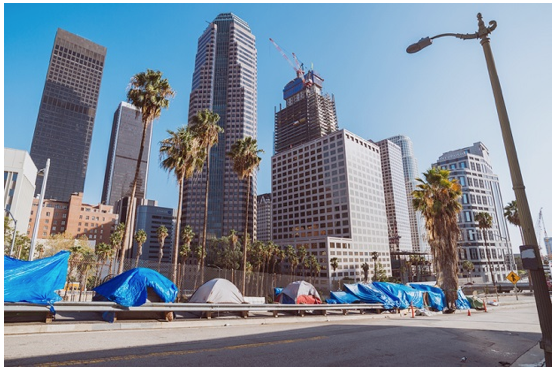CommentsPLATKIN ON PLANNING-Driving through Skid Row, witnessing homeless encampments near luxury apartment complexes, encountering people living in their cars, hearing stories about long commutes to the Antelope Valley for cheaper housing, or reading the latest data of soaring housing prices and rents lets you know that LA is in the midst of a severe housing crisis.
This is not news, but the latest report (Worst Case Housing Needs 2017 Report to Congress) from the U.S. Department and Housing and Urban Development (HUD) documents that it is much worse than you thought.
- Los Angeles and New York top the list of U.S. cities in which residents either live in substandard housing or have a heavy a rent burden.
- Los Angeles has 1 million very poor households, 57 percent of which spend more than half their income on housing, much of which is substandard.
- LA’s homeless population grew by 23 percent last year, and one of the chief causes was rising rents.
- According to Zillow, a 5 percent increase in rents next year will create 2,000 new homeless people in Los Angeles.
- KPCC reports that at least 800,000 people in Los Angeles qualify for Section 8 housing, but only a small fraction of them will obtain affordable units.
- When a two-week Section 8 window opens later in 2017, about 600,000 Angelinos will apply, but only 20,000 will obtain a voucher. The remaining applicants will be placed on a wait list.
- Los Angeles already has a backlog of 50,000 granted Section 8 vouchers, but only has 2,400 new ones to offer in this round, half of which are dedicated to permanent supportive housing for the homeless.
- As result of Initiative HHH, “It’s likely a larger percentage of the Section 8 vouchers will be used for the homeless.”
- This leaves about 400 units per year for low-income tenants who are not homelessness.
- Affordable housing money generated through the new Measure H sales tax is dedicated to housing for the homeless, but not for low income tenants who are not (yet) homeless.
- President Trump’s proposed budget cuts will reduce the Section 8 program by 3 percent, which translates into a loss of 5000 vouchers.
- Only 60 percent of local landlords will take Section 8 vouchers. As a result, some of those who finally obtain a voucher will not find a rental unit in Los Angeles.
Is there a light at the end of this housing crisis tunnel?
Most of us cannot see it, but according to Los Angeles Mayor Eric Garcetti, it is there, and it can be found in his June 30, 2017, Quarterly Status Report on Directive 13: Support for Affordable Housing. When set next to the HUD report and the additional information compiled by KPCC and Zillow, there is little to cheer about, however:
The Mayor’s goal is to build 15,000 new affordable units between 2013 and 2021, or approximately 2000 units per year.
To date (2013-2107), Los Angeles has built slightly less than 6,000 new affordable units, but this total includes preserved affordable units and first-time homebuyer loans. If those are excluded from the Mayor’s list, the total of actual new affordable units constructed in Los Angeles since 2013 is around 4,000. This amounts to 1000 units per year.
This figure, unfortunately, is less than the number of rent stabilized units removed from the market each year through evictions, such as 1370 units lost in 2016. If we also include affordable apartments demolished to build Small Lot Subdivisions and market-rate apartment buildings, as well as homes destroyed to make way for McMansions, the loss of lower-priced housing in Los Angeles is closer to 3000 units per year. This means that the Mayor’s program is not even treading water. At best, it is only modestly slows the growth of the LA’s housing crisis.
Most curiously, the Mayor’s report makes no mention of the new affordable units supposedly created by the construction of expensive market-rate condos and apartments. While this was a staple argument of the no on Measure S campaign in early 2017, there is no reference to these units in the Mayor’s latest affordable housing report. My explanation for this unexpected omission, though, is straightforward. All those claims that the accelerated construction of market housing would magically create affordable housing were myths.
Increasing the supply of expensive apartments does not and will not create affordable housing through either “supply and demand” or “filtering.” In fact, there is no data at all to back up these election claims, and the Mayor knows there is no way he could include these phantom units in his quarterly affordable housing report. It would discredit his report even more than his inclusion of preserved affordable units and first-time home loans.
Yes, the no-on-S crowd, the YIMBYs, the developers, the trolls, the SG & A campaign consultants, the elected officials, the newspaper editorialists, and the academic housing specialists peppered us with these housing supply claims prior to the February 2017 election. But, when push came to shove, the Mayor had absolutely no such affordable housing units he could fold into his report. Despite his election rhetoric, those units were no where to be found.
The combination of these two reports is startling, and they lead us to an obvious conclusion. The City of Los Angeles is not remotely capable of solving its enormous housing crisis through slippery bookkeeping, market incentive programs, small sales tax increases, and inclusionary housing ordinances.
Instead, there is only one entity that historically demonstrated it could build sufficient affordable housing, and that is the Federal government. While its public housing and subsidized housing programs are largely dormant, at this point there is a not-so-secret ingredient to bring them back to life: MONEY.
(Dick Platkin is a former Los Angeles city planner who reports on local planning issues for City Watch LA. Please send any comments or corrections to [email protected].) Prepped for CityWatch by Linda Abrams.
-cw
















